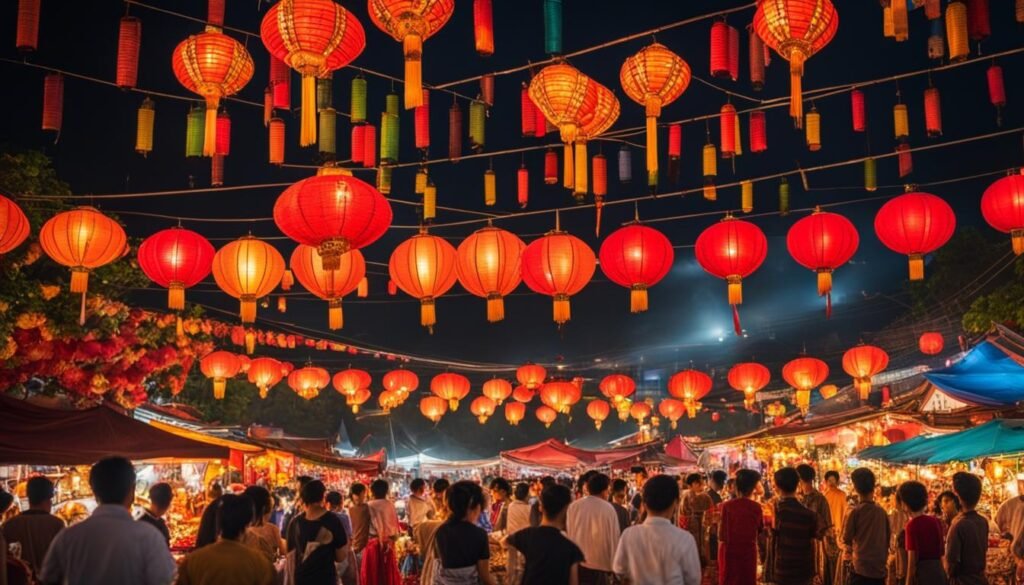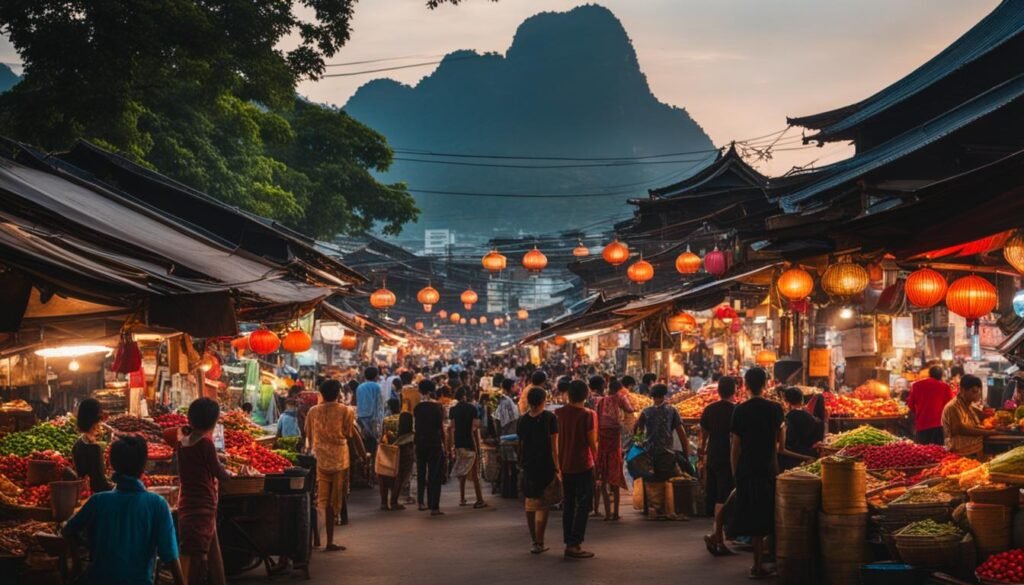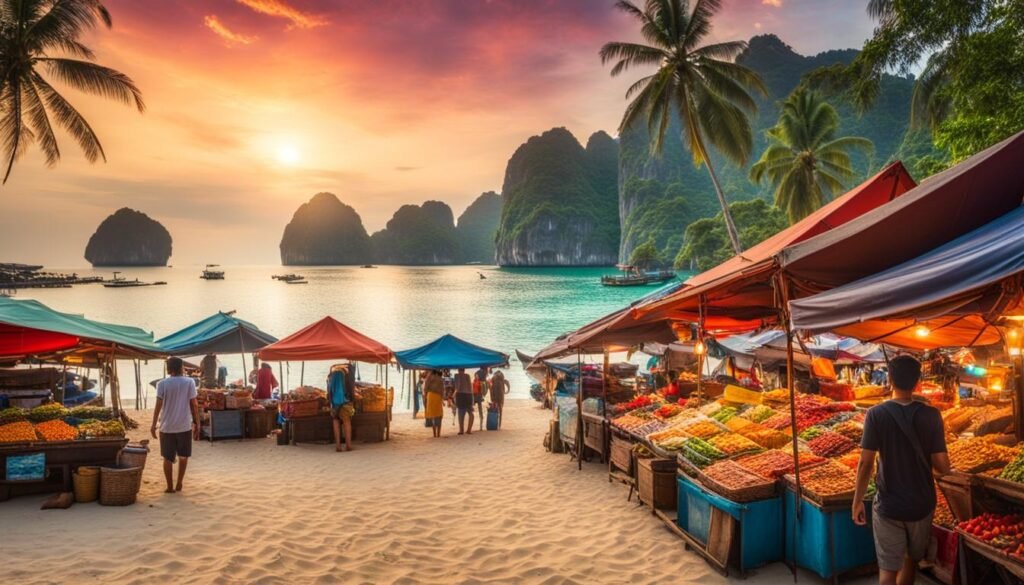Welcome to the world of Southeast Asia’s most captivating festivals! The region boasts a rich cultural tapestry, with an array of vibrant fiestas, traditional events, and cultural celebrations that mark the annual calendar. These festivities, grounded in religious customs, harvest seasons, and ancient folklore, offer a fascinating glimpse into the diverse Southeast Asian cultures. Whether you’re a seasoned traveler or just curious about global traditions, we invite you to embark on an exhilarating journey. Delve into Thailand’s water-soaked Songkran, Malaysia’s colorful Holi celebrations, or Vietnam’s mesmerizing lunar new year, Tet Nguyen Dan. Your adventure starts here.
Key Takeaways
- Southeast Asia is home to a myriad of vibrant festivals, showcasing its diverse cultures and traditions
- Celebrations are steeped in religious practices, harvest seasons, and ancient folklore
- Annual events provide an unparalleled look into the unique customs and communal values of each country
- Festive experiences range from water fights in Thailand to colorful processions in Malaysia and Indonesia
- Travelers can immerse themselves in the local culture and participate in joyous, unifying celebrations
Immersive Cultural Experience: Understanding Southeast Asia’s Festivals
Festivals in Southeast Asia are not just annual events; they are a profound means of expression of the region’s cultural diversity and religio-socio values. They serve numerous functions, from honoring deities like Lord Murugan during Thaipusam in Malaysia to embodying the local spirit during Thailand’s Phi Ta Khon, which celebrates ghosts and spirits. In Bali, the Nyepi marks a day of silence and reflection, highlighting a sense of community discipline and introspection. Similarly, Vietnam’s Mid-Autumn Festival signifies familial bonds and agricultural appreciation through vibrant, child-centric festivities.
The Significance of Festivals in Southeast Asian Cultures
Each Southeast Asian festival has its unique set of customs and traditions, often encompassing elaborate preparations. Malaysia’s Gawai Dayak Festival heralds a new harvest with rice wine brewing and cake preparations. The Bali Kite Festival involves kite flying as a sporting and religious event, thanking the gods for harvests. Meanwhile, Myanmar’s Taung Byone Nat festival includes offerings and dances to spirits, a blend of religious and traditional practices.
Traditions Unveiled: A Prelude to Southeast Asia’s Festive Celebrations
“Southeast Asian festivals emphasize cultural heritage and local traditions, allowing participants to appreciate the region’s rich history and vibrant customs.”
An essential part of understanding these traditional asian festivities is learning about the customs and practices that accompany them. For example, during the Gawai Dayak Festival in Malaysia, it is customary to greet others with a glass of rice wine and visit family members, reinforcing social bonds within the community.
Senses in Harmony: The Audiovisual Spectacle of Southeast Asian Festivities
The audiovisual allure of cultural celebrations in asia is undeniable: Thailand’s Songkran transforms towns into splashy battlegrounds, while Malaysia’s Thaipusam and Indonesia’s Diwali stand out with their music and dance. In Myanmar, Thadingyut is marked by lights that create a serene ambiance. Visitors can indulge their senses as streets come alive with decorations, sounds, and performances, truly encapsulating the region’s festive spirits.
- Thailand: Songkran Water Festival
- Malaysia: Thaipusam
- Indonesia: Diwali, Festival of Lights
- Myanmar: Thadingyut, Festival of Lights
- Vietnam: Mid-Autumn Festival
- Bali: Nyepi, Day of Silence
By immersing oneself in these southeast asian traditions, it is possible to gain a deeper understanding of the local customs and traditions that shape the region’s cultural identity. Each festival provides a unique opportunity to witness, engage with, and learn from the diverse and vibrant heritage that informs the vibrant tapestry of life in Southeast Asia.
Embarking on a Festive Journey: A Tour of Southeast Asia’s Vibrant Fiestas
Southeast Asia beckons travelers to its myriad of festivals, each a testament to its cultural richness. A journey through these vibrant fiestas allows you to experience Asian culture firsthand, witnessing the variety of local customs and traditions that have come together over centuries, and engaging with the Southeast Asian community during these celebratory events.
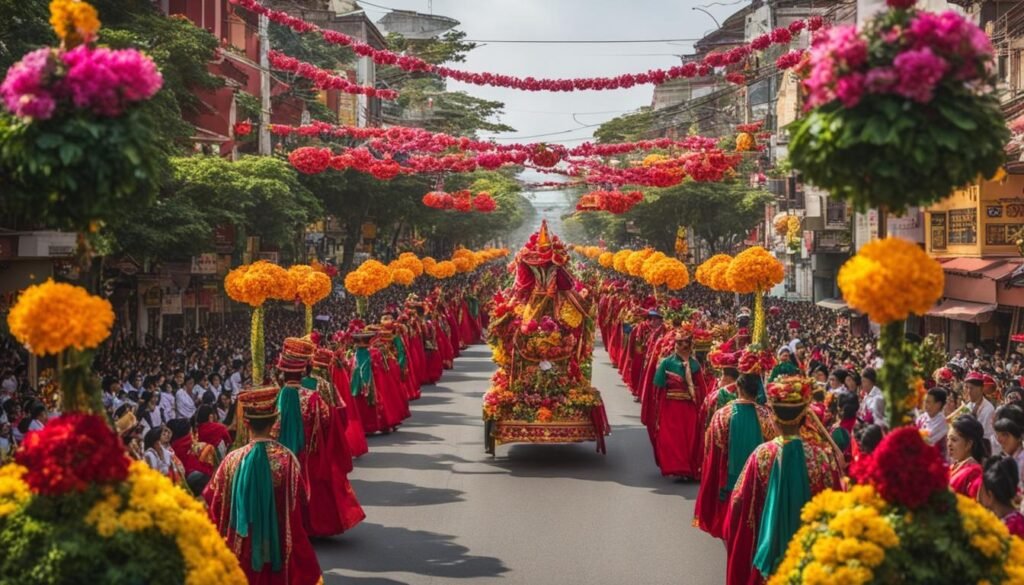
To truly appreciate the festivities, a well-rounded tour of these signature events is recommended. Your journey might span:
- Thailand: Participate in the water-soaked revelries of Songkran, the Thai New Year.
- Bali, Indonesia: Reflect on the solemnity and tranquility of Nyepi, the Balinese Day of Silence.
- Laos: Experience spirited rocket competitions during the Boun Bang Fai Rocket Festival.
- Cambodia: Be enchanted by illuminated boat processions that mark the Bon Om Touk Water and Moon Festival.
Each destination offers a festive slice of local life, punctuated by merriment and heritage.
Moreover, the appeal of experiencing the festivals of Southeast Asia lies not only in the events themselves but also in the fascinating stories and local legends associated with them. The rich folklore and beliefs behind each celebration imbue these vibrant fiestas with deeper significance that is inherent to their respective Southeast Asian communities.
| Festival | Country | Folklore/Belief |
|---|---|---|
| Songkran | Thailand | Water symbolizes purification and renewal for the new year. |
| Nyepi | Bali, Indonesia | A day of silence and self-reflection cleanses the mind and spirit for the year ahead. |
| Boun Bang Fai | Laos | Rockets are launched into the sky to provoke the rain gods and ensure a bountiful rice harvest. |
| Bon Om Touk | Cambodia | The boat processions celebrate the natural phenomenon of the Tonle Sap River changing direction. |
By embarking on a festive journey across the region, you can immerse yourself in the colorful celebrations that showcase the diverse traditions and customs of Southeast Asian communities. Experiencing these vibrant festivals allows for an unforgettable encounter, not only with the individuality of each event, but also with how they come together to create a rich, interconnected cultural tapestry unique to Southeast Asia as a whole.
A Feast for the Senses: The Culinary Delights at Southeast Asian Festivals
Experiencing the exhilarating southeast asia festivals goes beyond just witnessing the spectacular events and performances; it also involves delving into the regions’ rich local cuisine and specialty dishes. A vital aspect of these celebrations is the culinary delights they offer, letting attendees indulge in unique, mouthwatering flavors that showcase each destination’s love for food and its cultural significance.
Exploring the Flavor Palette: Local Cuisine and Specialty Dishes
The remarkable festivals of Southeast Asia boast a wide range of foods, from traditional dishes to contemporary twists. During Vietnam’s Tet, locals prepare glutinous rice cakes called Banh Chung, symbolizing unity and prosperity. The Mid-Autumn Festival, also in Vietnam, tempts visitors with Mooncakes, delicate pastries filled with sweet or savory ingredients. The Philippines’ Pahiyas Festival not only showcases colorful agricultural displays but also highlights sumptuous produce and delicacies.
The Role of Street Food in Festival Celebrations
Street food plays an indispensable role, offering sustenance and a taste of local culture in bustling settings. The Chinese New Year is celebrated with families sharing traditional, homemade dishes, while in Laos, the Rocket Festival is marked with eating, drinking, and merrymaking. The vibrant street food culture thrives during Thailand’s Songkran Festival, where streets transform into a culinary paradise with vendors offering both traditional and innovative treats.
From the irresistible aroma of skewered meats to the invigorating taste of tropical fruits, street food at Southeast Asian festivals excites the senses and the soul.
Beyond Taste: The Social and Cultural Significance of Festival Foods
Festival foods in Southeast Asia carry social and cultural meanings, promoting community ties and cultural continuity. The brewing of rice wine for Malaysia’s Gawai Dayak is a communal affair, reinforcing social bonds and shared experiences when enjoyed together.
| Festival | Country | Signature Dish | Cultural Significance |
|---|---|---|---|
| Tet | Vietnam | Banh Chung | Unity and prosperity |
| Mid-Autumn Festival | Vietnam | Mooncake | Family reunion and agrarian celebration |
| Pahiyas Festival | Philippines | Kiping and Pancit | Agricultural bounty and thanksgiving |
| Gawai Dayak | Malaysia | Tuak (rice wine) | Communal harmony and connections |
| Songkran | Thailand | Khao Chae | Celebration of the new year and Thai identity |
By indulging in the diverse festival foods during Southeast Asia’s vibrant celebrations, locals and tourists alike participate in preserving and promoting the region’s unique history, culture, and values, all while creating unforgettable memories. Be sure to savor the dining experiences on your next asian festival tourism adventure!
The Spiritual Canvas: Religious and Mythological Roots of Southeast Asian Celebrations
Southeast Asian traditions reveal a plethora of local festivals across Asia, showcasing a myriad of religious and mythological influences. These diverse and vibrant celebrations provide travelers with unique Asian cultural experiences, immersing them in the spiritual roots that form the bedrock of each festival.
“The religious and mythological roots of Southeast Asian celebrations are both profound and wide-ranging.”
Thaipusam in Malaysia is an exquisite example of Hindu beliefs and practices embedded in festivities. Devotees of Lord Murugan embark on a physically and mentally challenging pilgrimage, carrying kavadi or milk pots to seek forgiveness and blessings.
Indonesia’s Diwali, the Hindu Festival of Lights, transforms night into day with lamps and candlelit processions, signifying the triumph of light over darkness and good over evil.
Similarly, Myanmar’s Phaung Daw Oo Pagoda Festival, one of the largest Buddhist gatherings in the country, sees locals paying homage to Buddha with a mesmerizing lake procession of golden Buddha statues, offering a hypnotic display of spirituality and devotion.
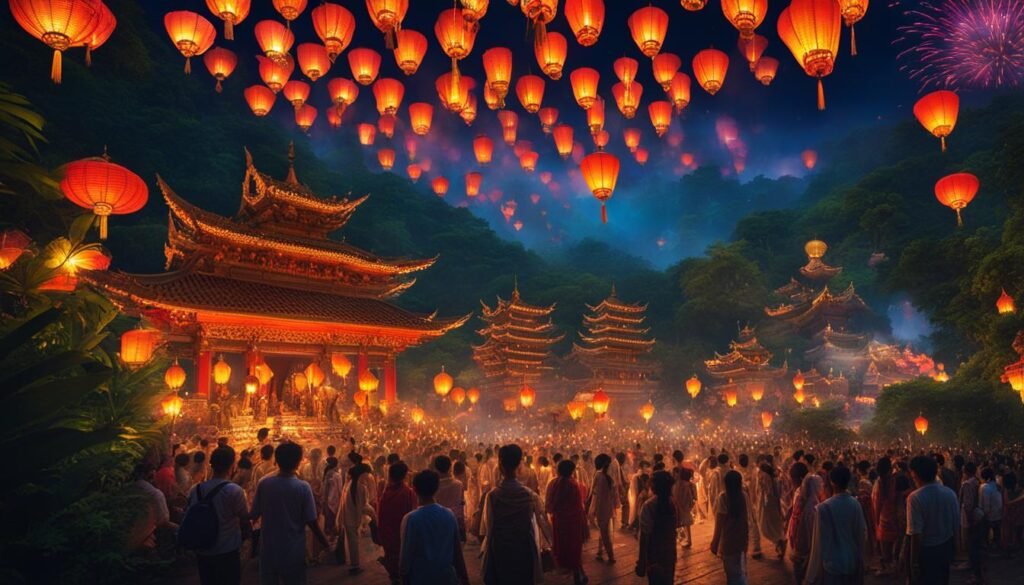
- Waisak Day in Indonesia, commemorating the birth, enlightenment, and demise of Gautama Buddha
- Pchum Ben in Cambodia, a time for remembering and paying respects to deceased ancestors
- Singapore’s Vesak Day, an important event for the Buddhist community to celebrate the birth, enlightenment, and passing away of Buddha
Each festival across Southeast Asia integrates spiritual traditions so deeply that they become inseparable from local life and culture, fostering a strong sense of communal identity and shared heritage. By participating in these celebrations, travelers are granted a rare glimpse into the spiritual canvas that forms the backdrop of Southeast Asian daily life, promoting cross-cultural understanding and fostering global unity.
Embracing Southeast Asia’s Rich Cultural Heritage and Festive Spirit
Experiencing the vibrant and diverse festivals of Southeast Asia provides not only a window into the region’s rich cultural continuity and asian cultural heritage, but also nurtures a sense of global unity. The sights, sounds, and flavors of these celebrations offer both locals and travelers a chance to cherish the traditional Asian performances that have persevered, weaving a profound understanding of Southeast Asia’s history, values, and essence.
As part of your experiential travel in Asia, participating in these celebratory events in Asia makes you part of the larger human mosaic, connected by the diverse festive seasons in Southeast Asia. To truly embrace these cultural-immersion opportunities, a southeast asia travel guide can prove invaluable. Through careful planning and understanding of local customs, your festival adventure can be a truly enriching journey through the region’s tapestry of colors, sounds, and flavors.
As you embark on your travels to witness the spectacle of Southeast Asian festivals, remember that these events play a crucial role in preserving the region’s heritage and fostering cultural continuity for generations to come. By engaging in these communal celebrations, you contribute not only to the global unity these festivities embody, but also support the preservation of the region’s rich heritage and living traditions. Join the celebration and let the vibrant spirit of Southeast Asia’s festivals captivate your senses and warm your heart.
FAQ
What are the most significant festivals in Southeast Asia?
Several prominent Southeast Asian festivals include Thai New Year (Songkran), Malaysia’s Holi, Vietnam’s Tet Nguyen Dan, Indonesia’s Diwali, Myanmar’s Thingyan, Laos’ Boun Bang Fai, and the Philippines’ Pahiyas Festival. Each of these events showcases unique cultural aspects across the region.
How can travelers make the most of their visit during festival season in Southeast Asia?
To have the best possible experience, travelers should plan their visit around the festival calendar, understand local customs to participate respectfully, and embrace local culinary and cultural offerings during the celebrations.
Why are festivals an essential aspect of Southeast Asian cultures?
Festivals in Southeast Asia hold deep cultural and religious significance, serving various purposes such as honoring deities, reflecting local beliefs, expressing cultural identities, and fostering community bonds.
What role does food play in Southeast Asian festivals?
Food plays an indispensable role in festival celebrations, offering unique local flavors, street food experiences, and fostering community ties. Festival foods also convey social and cultural meanings, contributing to cultural transmission and bonding among attendants.
Are Southeast Asian festivals mainly religious events?
While many Southeast Asian festivals have religious roots and involve spiritual traditions, they also encompass local folklore, community values, and cultural heritage. These celebrations offer a blend of the region’s diverse beliefs and practices, often contributing to community bonding and cultural continuity.

